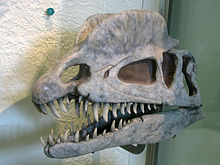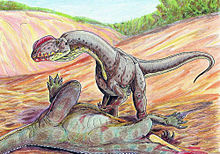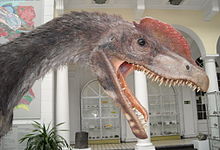
Dilophosaurus
About this schools Wikipedia selection
SOS Children, which runs nearly 200 sos schools in the developing world, organised this selection. A quick link for child sponsorship is http://www.sponsor-a-child.org.uk/
| Dilophosaurus Temporal range: Early Jurassic, 193Ma |
|
|---|---|
 |
|
| Cast of the holotype with skull restored after the second specimen, Royal Ontario Museum, Toronto, Canada | |
| Scientific classification |
|
| Kingdom: | Animalia |
| Phylum: | Chordata |
| Class: | Reptilia |
| Order: | Saurischia |
| Family: | †Dilophosauridae |
| Genus: | †Dilophosaurus Welles, 1970 |
| Species | |
|
|
| Synonyms | |
|
|
Dilophosaurus (pron.: / d aɪ ˌ l ɒ f ɵ ˈ s ɔr ə s / dy-LOF-o-SAWR-əs or / d aɪ ˌ l oʊ f ɵ ˈ s ɔr ə s /; Greek: di for "two", lophos "crest", and sauros "lizard") is a genus of theropod dinosaur from the Sinemurian stage of the Early Jurassic Period, about 193 million years ago. The first specimens were described in 1954, but it was not until over a decade later that the genus received its current name.
Dilophosaurus has appeared several times in popular culture, such as in the 1993 film Jurassic Park.
Description
Dilophosaurus measured around 7 metres (23 ft) long and may have weighed 500 to 1,000 kilograms (1,100 to 2,200 lb).
The most distinctive characteristic of Dilophosaurus is the pair of rounded crests on its skull, made up of extensions of the nasal and lacrimal bones. These are considered to be too delicate for anything but display purposes. Dodson (1997) noted that cranial crests first appear in Dilophosaurus and later in other theropods.
The teeth of Dilophosaurus are long, but have a fairly small base and expand basally. Dilophosaurus had 12 maxillary teeth and as many as 18 dentary teeth, and the teeth were smaller in the tip of the upper jaw. The second and third front teeth feature serrations, which are absent in the fourth. Another skull feature was a notch behind the first row of teeth, giving Dilophosaurus an almost crocodile-like appearance, similar to the putatively piscivorous spinosaurid dinosaurs. This "notch" existed by virtue of a weak connection between the premaxillary and maxillary bones of the skull. The braincase is well known in Dilophosaurus, and is significant in that it bears a feature of the top side wall that is absent in ceratosaurians. Compared to ceratosaurians, the distal scapular expansion in D. wetherilli is uniquely rectangular. The upper leg bone (femur) is longer than the lower leg (tibia).
According to Rauhut (2000), Dilophosaurus can be distinguished based on the following features:
- lacrimal with thickened dorso-posterior rim
- cervical vertebrae have neural spines with a distinct central "cap" and an anterior and posterior "shoulder"
- scapular blade with squared distal expansion.
Carrano et al. (2012) diagnosed Dilophosurus based on the following characters:
- thin, paired nasolacrimal crests extending vertically from skull roof, each with fingerlike posterior projection.
Studies by Gay (2005) show no indication that sexual dimorphism was present in the skeleton of Dilophosaurus, but say nothing about crest variation.
Classification
Dilophosaurus may be a primitive member of the clade containing both ceratosaurian and tetanuran theropods. Alternatively, Welles (1954) and several other paleontologists classify this genus as a large coelophysoid. Phylogenetically, Smith (2007) considered the genus Cryolophosaurus as the closest known relative of Dilophosaurus.
Discovery and species
Holotype UCMP 37302
The first Dilophosaurus (UCMP 37302) specimens were discovered by Sam Welles in the summer of 1942 in the Kayenta Formation in Arizona. The specimen was brought back to Berkeley for cleaning and mounting, where it was given the name Megalosaurus wetherilli in 1954. Returning to the same formation in 1964 to determine from which time period the bones dated, Welles found a new specimen not far from the location of the previous discovery. The specimens were renamed Dilophosaurus in 1970, based on the double crest clearly visible in the new skeleton. The available evidence strongly suggests that the holotype (specimen on which a name is based) of D. wetherilli is a young subadult.
Paratypes
Gay (2001b) reported on the discovery of two, possibly three specimen of Dilophosaurus wetherilli in the collections of the Museum of Northern Arizona. The specimens were collected in 1978 from the Kayenta Formation, in the Rock Head Quadrangle. Gay found the specimens to compare favorably with the holotype (UCMP 37302). Gay noted that this material is significant in that it includes parts of the pelvis not preserved in either the holotype or in the D. breedorum specimen UCMP 77270.
Infant specimen
Gay (2001b) reported that some elements in the MNA collection were representative of an infant specimen (MNA P1.3181). This included a distal humerus, a partial distal fibula and a tooth fragment. The infant specimen is significant for several reasons: first, it lends insight into the growth rates of early dinosaurs; second, it provides researchers with an opportunity to compare the growth rate of Dilophosaurus with that of a related taxon ( Coelophysis) which would provide insights into early theropod growth rates; third, this specimen is the first known infant of the genus.
Other species
Shaojin Hu (1993) assigned specimen KMV 8701 to a second species, Dilophosaurus sinensis, which may or may not belong to this genus. This species was recovered from the Yunnan Province of China in 1987, with the prosauropod Yunnanosaurus. Compared to D. wetherilli, D. sinensis is larger and more robust. It is possibly closer to the Antarctic theropod Cryolophosaurus, based on the fact that the anterior end of the jugal does not participate in the internal antorbital fenestra and that the maxillary tooth row is completely in front of the eye socket. Dilophosaurus sinensis was exhibited in 1998 at Dinofest in Philadelphia. Although the skull of D. sinensis sports large nasolacrimal crests superficially like those reconstructed in D. wetherilli, features elsewhere in the skeleton suggest it is closer to tetanuran theropods. Rauhut (2003) regarded D. sinensis as a basal tetanuran most closely related to Sinosaurus and Cryolophosaurus. Lamanna et al. (1998b) examined the material ascribed to D. sinensis and found it to be synonymous with Sinosaurus triasscus.
A proposed third species, D. breedorum, was coined by Samuel Welles through Welles and Pickering (1999) for the specimen UCMP 77270 collected in 1964. Tykoski (2005) performed an ontogenetic analysis in his thesis and concluded that D. breedorum is an adult Dilophosaurus wetherilli. This was the first specimen of the genus to preserve a nearly complete cranial crest. Welles' original specimen lacked well-preserved crests, and he suggested that the crested specimens pertained to a different species. He was unable to complete a manuscript describing this during his lifetime, and the name eventually came out in a private publication distributed by Pickering. This species has not been accepted as valid in other reviews of the genus.
Paleobiology
Cranial ornamentation
The crests on the skull of Dilophosaurus are considered to be cranial ornamentation for use in attracting mates. Padian, Horner and Dhaliwal (2004) challenged conventional hypotheses that that the purpose of bizarre cranial structures and post-cranial armor in dinosaurs, was either for attracting mates, intimidating/fighting rivals in the group, or intimidating potential predators of other species. Padian et al. noted that based on phylogenetic, histological, and functional evidence these bizarre structures can be explained by the phenomenon of intra-species recognition, which is supported by the fossil evidence.
Feeding
The presence and distribution of non-interdigitating sutures in the skull of some reptilian groups, including Dilophosaurus, has been interpreted as indicating the presence of a system of levers, driven by jaw muscles, as an aid to predation. Welles (1984) rejected this hypothesis and interpreted the potential mobility in the skull of Dilophosaurus as a sign of weakness, and argued that the loose connection of the premaxilla precluded the capture and subduing of prey. This led to the early hypothesis that Dilophosaurus scavenged off dead carcasses, because its teeth were too weak to bring down large prey.
Growth
Tkach (1996) conducted a study of the bone structure of the type species and concluded that Dilophosaurus wetherilli could have attained growth rates of nearly 35 kilograms (77 lb) in early life, which reflects a rapid growth rate.
Locomotion
Dilophosaurus is considered to have been an obligate biped based on the presence of long hindlimbs oriented vertically under the pelvis, and short forelimbs that did not support quadrupedal locomotion. The hindlimbs suggest a fast and agile runner, as would be expected in a carnivorous theropod.
Ebel (2000) published a controversial study that challenged the assumption that most dinosaurs were terrestrial. Regarding Dilophosaurus, which is widely considered terrestrial, Ebel noted that the short neural spines of the dorsal vertebrae located between its shoulder and pelvic girdles indicated that “the stress of the vertebral column was relatively low, and therefore the animal does not appear to have been adapted to an terrestrial environment and probably lived in moderately shallow water.”
Paleopathology
One Dilophosaurus wetherilli specimen shows potential damage "due to injury or crushing" to a vertebra, and a potential abscess on a humerus. A Dilophosaurus wetherilli is also known with an unusually small left humerus compared to a very robust right arm, a possible example of "fluctuating asymmetry". Fluctuating asymmetry results from developmental disturbances and is more common in populations under stress and can therefore be informative about the quality of conditions a dinosaur lived under.
In a 2001 study conducted by Bruce Rothschild and other paleontologists, 60 foot bones referred to Dilophosaurus were examined for signs of stress fracture, but none were found.
Social behaviour
Welles (1984) proposed that Dilophosaurus traveled in small groups, based on the fact that several individuals were found together. Gay (2001b) noted that there was no direct evidence for this and noted that "flash floods would pick up scattered and isolated material from different individuals and deposit them together in the same area." Cranial display features make sense in social, gregarious animals, where other members of the species are available to observe and interpret messages of sexual status.
Paleoecology
Dilophosaurus remains were recovered in the Kayenta Formation, in northeastern Arizona. The Kayenta Formation is part of the Glen Canyon Group that includes formations not only in northern Arizona but also parts of southeastern Utah, western Colorado, and northwestern New Mexico. It is composed mostly of two facies, one dominated by silty deposition and the other dominated by sandstone. The siltstone facies is found in much of Arizona, while the sandstone facies is present in areas of northern Arizona, southern Utah, western Colorado, and northwestern New Mexico. The formation was primarily deposited by rivers, with the silty facies as the slower, more sluggish part of the river system. Kayenta Formation deposition was ended by the encroaching dune field that would become the Navajo Sandstone.
A definitive radiometric dating of this formation has not yet been made, and the available stratigraphic correlation has been based on a combination of radiometric dates from vertebrate fossils, magnetostratigraphy and pollen evidence. It is been surmised that the Kayenta Formation was deposited during the Sinemurian and Pliensbachian stages of the Early Jurassic Period or approximately 196 to 183 million years ago.
The Kayenta Formation has yielded a small but growing assemblage of organisms. Most fossils are from the silty facies. Most organisms known so far are vertebrates. Non-vertebrates include microbial or "algal" limestone, petrified wood, plant impressions, freshwater bivalves and snails, ostracods, and invertebrate trace fossils.
Vertebrates are known from both body fossils and trace fossils. Vertebrate known from body fossils include (the following after Lucas et al. [2005], except where noted): hybodont sharks, indeterminate bony fish, lungfish, salamanders, the frog Prosalirus, the caecilian Eocaecilia, the turtle Kayentachelys, a sphenodontian reptile, lizards, several early crocodylomorphs including Calsoyasuchus, Eopneumatosuchus, Kayentasuchus, and Protosuchus), the pterosaur Rhamphinion, several theropods including Dilophosaurus, Kayentavenator "Syntarsus" kayentakatae, and the "Shake N Bake" theropod, the basal sauropodomorph Sarahsaurus, a heterodontosaurid, armored dinosaurs Scelidosaurus and Scutellosaurus, the tritylodontids synapsids Dinnebiton, Kayentatherium, and Oligokyphus, morganucodontids, possible early true mammal Dinnetherium, and a haramyid mammal. The majority of these finds come from the vicinity of Gold Spring, Arizona. Vertebrate trace fossils include coprolites and the tracks of therapsids, lizard-like animals, and several types of dinosaur.
Explorations in the 1970s and 1980s by James M. Clark, Farish Jenkins and David E. Fastovsky and collection and analysis by William R. Downs have produced several vertebrate specimens. The Kayenta Formation has produced several mass burial sites, and the remains of three coelophysoid taxa of different body size, which represents the most diverse ceratosaur fauna yet known.
Ichnology
In the Kayenta Formation in Arizona, the same formation that yielded the original specimens for this genus, the trackways known as Kayentapus hopii and Dilophosauripus williamsi were attributed to Dilophosaurus by Welles (1971). These ichnotaxa feature a series of three-toed footprints that are consistent with the expected size and shape of the feet of Dilophosaurus. In 1991, trackway specialist Gerard Gierlinski re-examined tracks from the Holy Cross Mountains in Poland and renamed them Kayentapus soltykovensis, concluding that the "dilophosaur" form was the most appropriate candidate for making these ichnotaxa. Tracks of an unidentified species of Dilophosaurus were found in Vallåkra, Sweden. A few of the tracks were taken to museums, but most of them disappeared in natural floodings. In 1994, Gierlinski and Ahlberg assigned these tracks from the Hoganas Formation of Sweden to Dilophosaurus as well.
Gierlinski (1996) observed unusual traces associated with a track specimen in the collection at the Pratt Museum in Amherst, Massachusetts. Specimen AC 1/7 is a "dinosaur sitting imprint", made when a dinosaur is resting its body on the ground, leaving an impression of its belly between a pair of footprints. Traces associated with AC 1/7 were interpreted by Gierlinski as the imprints of feathers, suggesting that Dilophosaurus was a feathered dinosaur.
In popular culture
Dilophosaurus is prominently featured in both Michael Crichton's 1990 novel Jurassic Park and its 1993 movie adaptation. It is depicted spitting blinding poison, aiming for the eyes to blind and paralyze its prey (much like a spitting cobra); in the film, it also has a retractable neck frill around its neck (much like a frill-necked lizard). There is no evidence to support either the frill or the venom spitting, which was acknowledged by Crichton as creative license. In the film, Steven Spielberg also reduced the size of Dilophosaurus to 3 feet (0.91 m) tall and 5 feet (1.5 m) long in order to avoid confusion with the velociraptors.
Despite its inaccuracies, the Jurassic Park depiction of Dilophosaurus has been taken up by others. Several video games, such as ParaWorld, Jurassic: The Hunted, Nanosaur and Ice Age: Dawn of the Dinosaurs, feature Dilophosaurus modeled after the representations in Jurassic Park, and The Whitest Kids U'Know sketch "Dinosaur Rap" (a music video for Trevor Moore's "Gettin' High With Dinosaurs") features a Dilophosaurus, complete with a short frill. A more accurately restored Dilophosaurus was featured in the documentary When Dinosaurs Roamed America.









